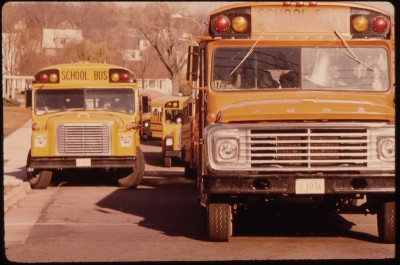the Hechinger Report
A new report showing that some high-achieving students fall behind (although not far behind) as they progress through school is reviving an argument in favor of tracking students by ability levels.
A new report showing that some high-achieving students fall behind (although not far behind) as they progress through school is reviving an argument in favor of tracking students by ability levels.
America’s focus on closing the achievement gap during the past decade has left “advanced students to fend for themselves,” Frederick Hess, a researcher at the American Enterprise Institute, argues in a blog post on the New York Times website. (Disclosure: Hess sits on the advisory board of The Hechinger Report.)
“If we want to do right by our highest-achieving students—and maintain America’s international competitiveness—we should rethink the move to eradicate tracking,” writesMichael Petrilli, executive vice president of the Thomas B. Fordham Institute, a conservative think tank that advocates for school choice and charter schools.
But critics of tracking have long argued that, on the ground, it has been very harmful to minority children, who have often been funneled into less challenging classes that don’t prepare them for college or careers.
Are we facing a crisis for high-achieving students? Is tracking the way to go to fix it? What do history and research tell us?
First, here is a synopsis and some thoughts on the report that is prompting the revival of the tracking debate, published by the Fordham Institute.
The Fordham report finds that a large number—though not a majority—of students who rank highly on tests in earlier grades lose ground in later grades (but not much ground: most stay at or above the 70th percentile). They are replaced by a larger number of so-called “late bloomers,” meaning that American schools are, overall, increasing the numbers of high-achievers by the end of high school. The report also finds that high-achieving students in high-poverty schools make the same amount of progress as high-achieving students in low-poverty schools. And, finally, low- and middle-achievers—groups that include a disproportionate number of minority and poor students—are catching up to their high-achieving peers.
This seems like mainly good news, but the report finds some nuggets of gloom.
Past research hasn’t found that the gains of low-performers come at the expense of high-performers, the report notes, although it has found that lower-performers generally make gains faster than high-performers. The Fordham report bolsters this finding: high-achievers didn’t show growth as quickly as middle- and low-achievers among the two groups of students studied. This finding suggests that American schools are making progress in closing the achievement gap, since 90 percent of the high-achievers in the sample are white, even though white students only make up 75 percent of the sample overall.
The authors also find this stunted growth among high-achievers “distressing,” however. The Fordham researchers hypothesize that the discrepancy in growth between the two groups is the result of schools’ focus on lower-achieving students. They suggest that No Child Left Behind’s elevation of standardized testing has forced schools to obsess over “bubble students”—the kids who are on the cusp of proficiency—to the detriment of others.
This analysis would probably get a “Hear, hear!” from many teachers and principals. But they might also talk about the difficulty of pushing high-achievers even higher. Helping a third-grader who still struggles to read fluently master the mechanics of reading is a different task than helping a third-grader who has already mastered reading understand a more difficult text, pushing the student fromCharlotte’s Web, say, to The Adventures of Tom Sawyer. The study addresses this issue briefly, in a footnote, noting that the test the authors use doesn’t have an achievement ceiling, but also that “at some point, reading development becomes subject dependent, and tests of general reading may not adequately measure it.”
One bright spot, according to the report’s authors, is the finding that poverty doesn’t matter when it comes to progress for high-achievers. But it does matter when it comes to achievement levels: In their study, higher poverty rates generally predicted lower overall academic performance. That is, high-achievers at high-poverty schools were in lower percentile ranks than their high-achieving peers at more affluent schools. So students in poor schools may progress at the same rate as students in wealthier schools, but they are still behind.
What does all of this mean? Petrilli says the findings should urge us to resume the practice of sorting students into different academic tracks by ability level, to ensure that high-achieving students don’t suffer from dumbed-down instruction. In further support of this argument, Hess points to a RAND Corporation study, which found that high-achieving students do worse if they’re in general-education classes.
Even if some high-achieving students lose ground because they are being slowed down by lower-achieving peers, critics of tracking argue that there’s good reason to be cautious about reviving the practice. C. Kent McGuire, president of the Southern Education Foundation, doesn’t dispute that high-achieving students might do better in an accelerated environment, responding to Petrilli and Hess’s arguments on the Times blog. McGuire warns, however, that tracking has a problematic history. (He also wonders whether tracking has really been eliminated from most schools, as Petrilli argues.)
Here is a (very) brief outline of tracking’s history:
The concept was born at the beginning of the last century, as immigrant children flooded the public-school system. The practice of separating children by ability picked up pace in the 1970s, just as school desegregation was getting under way in many cities.
In theory, tracking would help the smartest students reach even greater heights. In reality, tracking did not always funnel the most intelligent children into challenging classrooms. Often, a designation of “gifted and talented,” or “advanced,” or “honors” was simply a proxy for social class, race or ethnicity.
A case in point is what happened in Louisville, Ky., the subject of a book I’m writing about the history of desegregation. Louisville introduced the Advance Program, an accelerated track for children who did well on an intelligence test and were recommended by their teachers, just after the courts forced the school district to begin busing. Perhaps this was a coincidence, but data show that even as the schools became integrated, the new tracking system kept blacks and whites mostly separate inside school walls.
In the 1990s, Louisville’s gifted and talented program was only 11 percent black, while the school system was 30 percent black. Black children were much less likely to take the test to get into the Advance Program track. Even when they did, and even if they scored above the cutoff for admission, they were less likely to be recommended for the program than their white peers. White students, on the other hand, were more likely to make it in even if they scored below the cutoff.
This was a trend that played out nationally in schools with tracking. (For a deeper look at the history of tracking, see this study, by researchers at the Education and the Public Interest Center in Boulder, Colo.) New York City has had a particularly fraught battle over ensuring that the gifted and talented label isn’t disproportionately assigned to white students.
The Fordham researchers argue that high-achieving students have been ignored as concerns about the achievement gap between minority and whites have escalated, and emphasize that the country’s economic and political future depends on how we nurture top-flight students. Their critics worry that reviving a system that has traditiona



Nenhum comentário:
Postar um comentário